Hi Everyone,
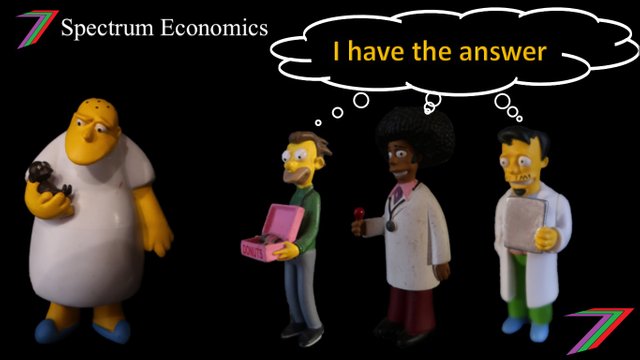
In this post, I want to look at approaches to problems and potential problems. Throughout my career as an economist, I have been involved with analysing responses to problems. I have found that responses or approaches generally come under three broad categories. These categories are prevent, solve or manage.
The ‘prevent’ approach involves stopping the problem from occurring in the first place. For example, not eating a rotten apple will prevent you from getting a stomachache. The ‘solve’ approach involves putting an end to the problem. For example, ingesting a remedy to cure your stomachache. The manage approach involves handling or mitigating the effects of the problem. For example, taking medication to reduce the pain caused from the stomachache.
Figure 1: Prevent, Solve, and Manage
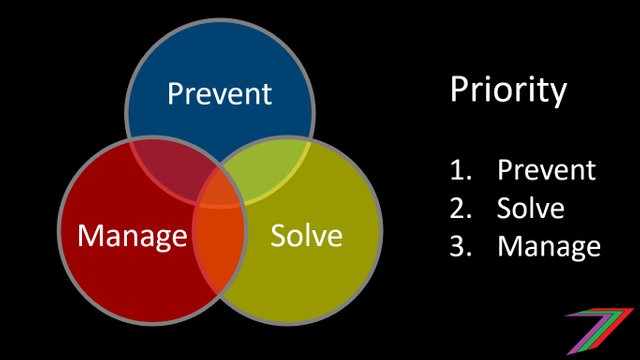
The Venn diagram in Figure 1 shows various possible combinations of the ‘prevent’, ‘solve’, or ‘manage’ approaches. Problems can be categorised as being preventable, solvable, manageable, any combination of the three or none of the three (outside the circles). If we assume the cost and the availability of the approaches is the same for each problem, ‘prevent’ is preferred to ‘solve’ and ‘solve’ is preferred to ‘manage’. Prevent is the best approach as it stops the problem from occurring. Solve is bad as the problem has occurred but at least the problem can be stopped. Manage is bad as the problem has occurred and will continue to linger but at least the harmful effects of the problem can be reduced.
Control
The ‘prevent’, ‘solve’, or ‘manage’ Venn diagram can also be viewed from the perspective of control. We have the most control over a problem that can be prevented, solved, and managed. We have the least control over a problem that cannot be prevented, solved, or managed. We have the second least control over a problem that we can only manage. Figure 2 contains the level of control we have over a problem based on our ability to prevent, solve, or manage it.
Figure 2: Level of control over problems
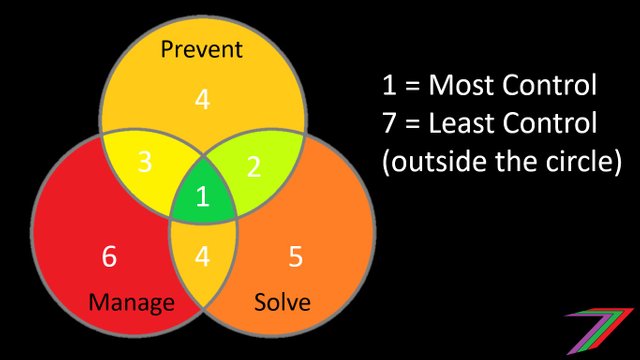
Of the three approaches, ‘prevent’ gives us the most control, followed by ‘solve’, and finally followed by ‘manage’. Having possible combinations of these approaches gives us even more control.
Risk
Another important aspect to consider is risk. The ‘prevent’, ‘solve’, or ‘manage’ Venn diagram can also be used to display risk. The problems with the highest risk are problems that can be prevented but not solved or managed. Once these types of problems have occurred they cannot be stopped or even mitigated. In this case, prevention is essential. The problems with the lowest risk are problems that can be prevented, solved and managed. These problems are low risk because even if the opportunity to prevent the problem is missed they can be solved or at least managed as a worst-case scenario. Figure 3 contains the level of risk in each section of the Venn diagram.
Figure 3: Risk of problems
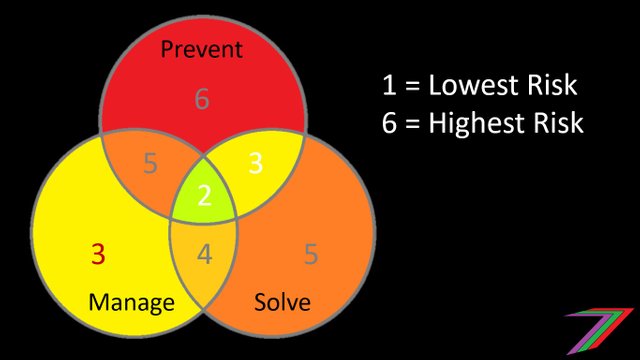
In the diagram, I have also considered problems that can be 'prevented and managed' as high risk, and problems that can only be 'solved' as high risk. Problems that can be prevented but cannot be solved are high risk as managing a problem often results in a considerably worse outcome than if it had been prevented. Problems that can only be solved are high risk because if they are not solved,there is no approach to mitigate them. This is especially so if the time frame is very tight.
Comparing control and risk
The ‘prevent’, ‘solve’, or ‘manage’ Venn diagram can provide a guide to both the level of control we have over a problem as well as the extent of the risk of the problem. Figure 4 compares the Venn diagrams in terms of control and risk.
Figure 4: Control vs. Risk
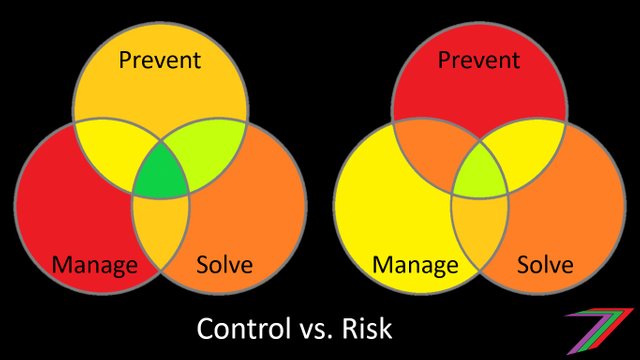
If there are more approaches available to tackle a problem, control increases and risk decreases. The centre of the Venn diagram is green for both control and risk. For problems limited to just one approach, there is the problem of either risk or control. When something is just preventable, we have control over the problem. However, prevention involves tackling a problem before it occurs, which could be a narrow window. If prevention is the only option available, nothing can be done once the problem has occurred (i.e. complete loss of control). When something is just manageable, there is very little control over the problem as it cannot be prevented or stopped at any point. However, the risk is often lower, as the problem can, most likely, be managed at many particular stages.
Prediction
A fourth circle that indicates the ability to predict a problem can be added to the Venn diagram. The ability to predict a problem decreases the risk of occurrence and improves our ability to solve or manage the problem. Figure 5 contains the adjusted Venn diagram
Figure 5: Prediction and risk
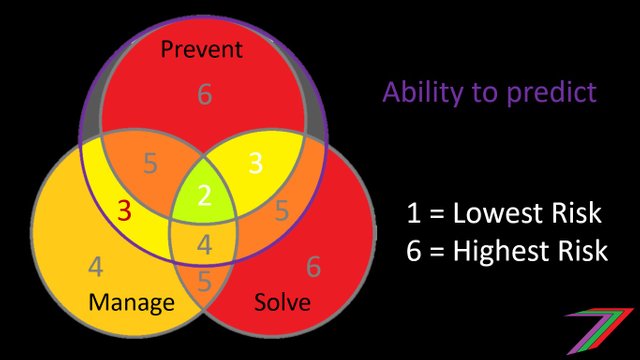
The prediction circle covers the entire ‘prevent’ circle and parts of the ‘manage’ and ‘solve’ circles. An imminent problem cannot be initially prevented if it cannot be predicted. Whereas, problems can be solved or managed whether they can be predicted or not. Predicted problems that can be solved, managed or both can be considered lower risk than problems that cannot be predicted as responses can be quicker. This is demonstrated in Figure 5, which shows increased risk to segments outside the ‘prevent’ circle.
Level of certainty
So far, this post has only discussed imminent problems. The ‘prevent’, ‘solve’, or ‘manage’ Venn diagram can be expanded to include all potential problems. Figure 6 includes a circle that indicates the level of certainty that a problem has of occurring. The area in the circle indicates problems that are certain to occur or are currently a problem. The area outside the circle indicates problems that could happen. Figure 6 contains the adjusted Venn diagram.
Figure 6: Certainty and risk
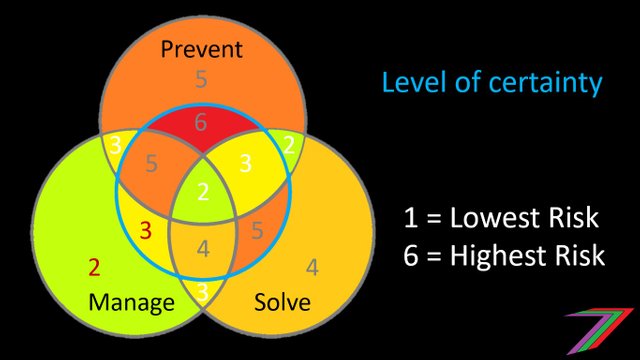
The areas outside the circle are lower risk as they may or may not happen. The colours in the Venn diagram indicate risk is roughly one level lower but this will vary considerably depending on the likelihood that a problem could occur.
What the Venn diagram does not consider
The Venn diagram does not consider the magnitude of the problem, the cost of each approach or the probability of success of the approach. Instead, the problems have been assumed to be of the same magnitude, of equal cost and of equal probability of succeeding. The problems have been assumed to have zero magnitude if prevented and have increasing magnitude as they persist.
The ‘prevent’, ‘solve’, or ‘manage’ Venn diagram should not be used in isolation to compare a variety of different problems. Instead, it should be used as representation of the problems. The Venn Diagram can aid further analysis by categorising the types of approaches that can be adopted.
Appropriate usage of the ‘prevent’, ‘solve’, or ‘manage’ approach
The ‘prevent’, ‘solve’, or ‘manage’ approach can be applied to a particular problem or used to analyse several problems. For a particular problem, it can be used to represent the probability of success for approaches or combinations of approaches. Figure 7 contains the probability of success of each approach as well as a numerical example.
Figure 7: Applying probabilities to the ‘prevent’, ‘solve’, or ‘manage’ approach
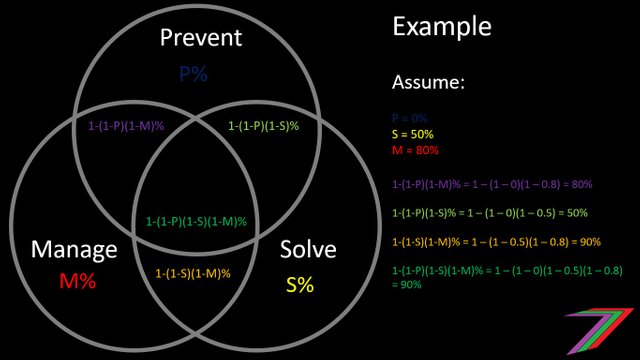
For the numerical example, I have assumed that the only approaches that could address the problem are ‘solve’ and ‘manage’. The example can be expanded further to include the costs of the problem and approaches. See Figure 8 for an example.
Figure 8: Costs of problem and approaches
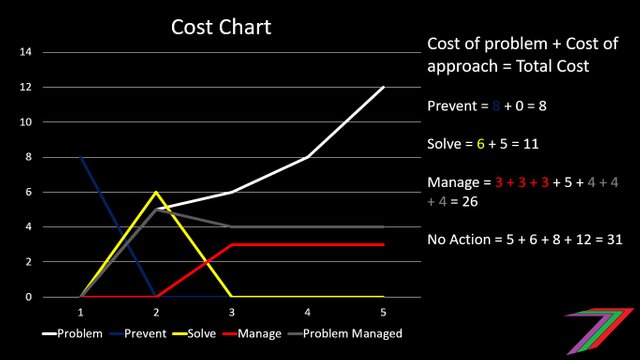
Costs of preventing and solving a problem have been assumed to be one-off costs and the costs of the problem ceases once they become effective. Costs of managing are assumed to continue into the future. The costs of the problem are assumed to continue but they are reduced from what they would have been if they had not been managed.
The costs calculated in Figure 8 can be applied to the probabilities displayed in Figure 7. Figure 9 contains the example if a ‘solve’ first and ‘manage’ second approach is adopted.
Figure 9: Applying probabilities to cost
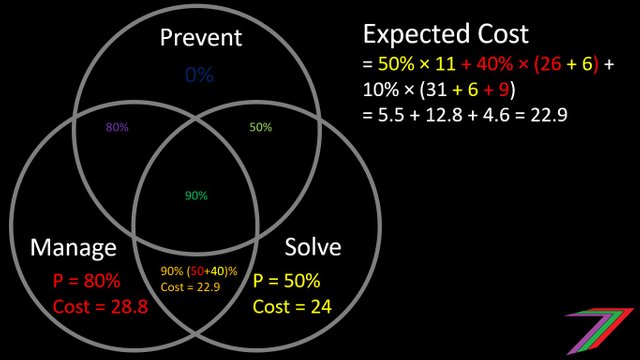
Figure 9 contains the calculation of the expected cost for a ‘solve’ first and ‘manage’ second approach. The Venn diagram also contains the costs of a ‘solve’ only approach and a ‘manage’ only approach. A ‘manage’ first and ‘solve’ second approach may not be available in many cases because of the time consumed by managing the problem. However, it is also possible that managing the problem first could increase the chances of success of attempting to solve the problem later. Circumstances will change depending on the nature of the problem.
Development of ‘prevent’, ‘solve’, or ‘manage’ solutions
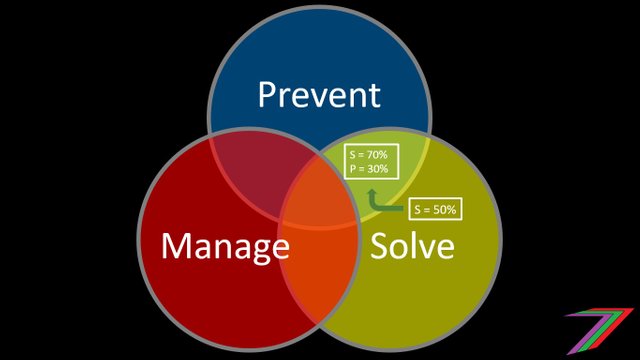
The ‘prevent’, ‘solve’, or ‘manage’ Venn diagram can be used to help develop ‘prevent’, ‘solve’, or ‘manage’ approaches. In the previous example, we did not have a workable ‘prevent’ approach. However, a ‘prevent’ approach could be investigated. The existing ‘solve’ and ‘manage’ approaches could also be improved to increase their level of success and in the case of ‘manage’ approaches, the cost of the problem could be reduced further. The three approaches could also be enhanced further to complement each other. For example, a ‘manage’ and ‘prevent’ approach could be used to increase the chances of success of a ‘solve’ approach, which could be used to tackle a problem of a reduced magnitude. There are many possible combinations of improvement that can be highlighted using the described Venn diagram.
Summary
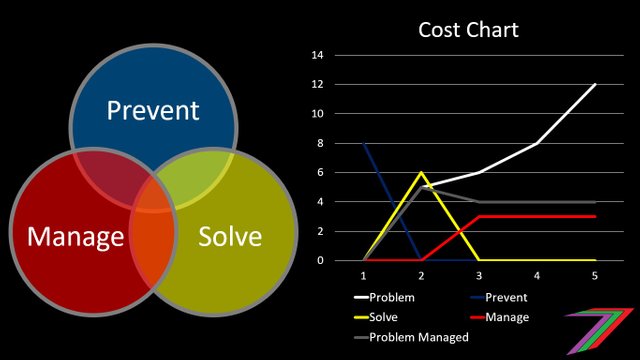
The ideas expressed in this post are not particularly new but the presentation of this information is a little different from more commonly used approaches to problem solving. The Venn diagram is a useful tool to help understanding relationships between approaches to problems. The inclusion of a priority of ‘prevent’, ‘solve’, and ‘manage’ is useful as a rule of thumb of how to begin an approach to a problem. However, all problems are different. They differ in terms of probability of occurrence and magnitude. Approaches to these problems also differ in terms of cost and effectiveness. Research can be done to improve the effectiveness and/or decrease the cost of the approach.
I will revisit the ‘prevent’, ‘solve’, or ‘manage’ approach discussed in this post when I explore particular types of problems in certain areas. These areas will include the following.
- Health
- Crime
- Housing
- Education
- Transport
- Immigration
- Money
- Leadership
I believe the ‘prevent’, ‘solve’, or ‘manage’ approach will be useful in helping to explore different methods to tackle problems that fall in the above areas.
These posts will also help test and shape the ‘prevent’, ‘solve’, or ‘manage’ approach. I believe almost all techniques and approaches should be considered as work-in-progress, as there is always room for improvement.
More posts

If you want to read any of my other posts, you can click on the links below. These links will lead you to posts containing my collection of works. These posts will be updated frequently.
Guide to the Steem Ecosystem (Udemy Course)

I have launched my Udemy course ‘Guide to the Steem Ecosystem’. This course takes you on journey through the Steem Ecosystem. The course consists of 6 sections. These sections are as follows:
- Getting Started
- Navigating Steem Frontends
- Becoming a Steem User
- Behind the Scenes
- The Wonders of the Steem Ecosystem
- Additional Content (SteemFest 4, SMTs, Communities, etc.)
The course contains 56 video lectures (about 13.5 hours of viewing), 56 multiple-choice questions (10 to 12 at the end of each section), and 59 downloadable resources (presentation slides and additional material such as white and blue papers). The course is free-of-charge. Click the link above to access the course.
I also have an economics course, titled Economics is for Everyone, which contains about 4 hours of video content.



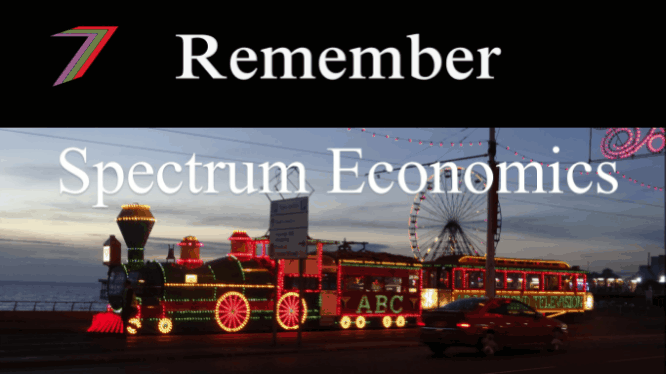
Steem - The Future of DApps
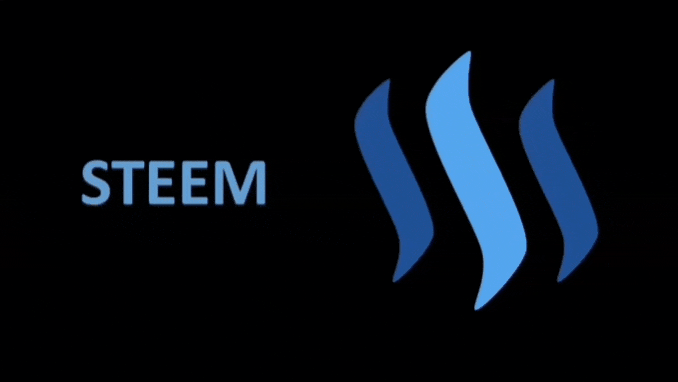




Sincerely happy to see your work getting financial credit it deserves.
Stay great fella and best wishes
Posted using Partiko Android
Downvoting a post can decrease pending rewards and make it less visible. Common reasons:
Submit
Thanks @nathen007. It's great to be on the trending page.
Posted using Partiko Android
Downvoting a post can decrease pending rewards and make it less visible. Common reasons:
Submit
Definitely beautiful, this is superbly analysed. In truth I often want to control before the damage is done, but sometimes there are situations that suffices without warning, I'm thinking we have to notice signs of something going wrong before we can prevent however what do we do when we have the opportunity to prevent a situation but we can't see any sign to portray or show that something is amiss?
Downvoting a post can decrease pending rewards and make it less visible. Common reasons:
Submit
It is going to vary considerably from problem to problem. Experience and knowledge can help us detect when something is likely to go wrong soon. However, even if we know something is about to go wrong, it does not mean we can actually stop it happening. We can better prepare ourselves. For example, predicting earthquakes, or volcanic eruptions. Just having more time can be critical.
Downvoting a post can decrease pending rewards and make it less visible. Common reasons:
Submit
Wow thanks, so when you say experience you mean like a repeating of a likely Situation that might have occurred before?
Downvoting a post can decrease pending rewards and make it less visible. Common reasons:
Submit
Situations are always different but we can often draw on events that are similar. We can also learn from other people who have had similar experiences.
Downvoting a post can decrease pending rewards and make it less visible. Common reasons:
Submit
Beautifully explained, thanks a whole lot
Downvoting a post can decrease pending rewards and make it less visible. Common reasons:
Submit
Your post has been chosen to be elevated to the trending page due to being awesome.
Photo by YesManProductions
Exceptional work! Very informative and well laid out. And burning half of the rewards too, I'm sure some people will like that!
Notificaton: @theycallmedan, @azircon, @smooth, @twinner, @superhardness, @postpromoter, @adsup, @redpalestino
Downvoting a post can decrease pending rewards and make it less visible. Common reasons:
Submit
That's great, thanks buddy.
Posted using Partiko Android
Downvoting a post can decrease pending rewards and make it less visible. Common reasons:
Submit
Not sure if understand this right. So basically, the problems with highest risk can not be solved, therefore preventing it from happening is the only opened solution? Otherwise the system will collapse?
Downvoting a post can decrease pending rewards and make it less visible. Common reasons:
Submit
I think of it more as the other way round. If a problem can be prevented but not solved or managed, it is critical to prevent it as there is nothing to fall back on. For example, if there is an explosion on a plane, the plane will crash. There is very little that can be done. Therefore, it is essential to prevent explosions occurring on planes.
Downvoting a post can decrease pending rewards and make it less visible. Common reasons:
Submit
I expressed my self poorly. Great article, the only bad thing around your content is that I have to be 100% concentrated in order to understand everything haha.
Keep em coming :D
Downvoting a post can decrease pending rewards and make it less visible. Common reasons:
Submit
Hi, thanks for the post! I have included a link and a short description in my daily Science and technology digest, and you'll receive a 10% share of that post's rewards.
Downvoting a post can decrease pending rewards and make it less visible. Common reasons:
Submit
That's really awesome, thank you.
Posted using Partiko Android
Downvoting a post can decrease pending rewards and make it less visible. Common reasons:
Submit
Nice bro... follow me
Downvoting a post can decrease pending rewards and make it less visible. Common reasons:
Submit
quite thoughtful
Downvoting a post can decrease pending rewards and make it less visible. Common reasons:
Submit
Hi @spectrumecons!
Your post was upvoted by @steem-ua, new Steem dApp, using UserAuthority for algorithmic post curation!
Your UA account score is currently 4.804 which ranks you at #1453 across all Steem accounts.
Your rank has not changed in the last three days.
In our last Algorithmic Curation Round, consisting of 84 contributions, your post is ranked at #35.
Evaluation of your UA score:
Feel free to join our @steem-ua Discord server
Downvoting a post can decrease pending rewards and make it less visible. Common reasons:
Submit
Thanks for the post.
Downvoting a post can decrease pending rewards and make it less visible. Common reasons:
Submit